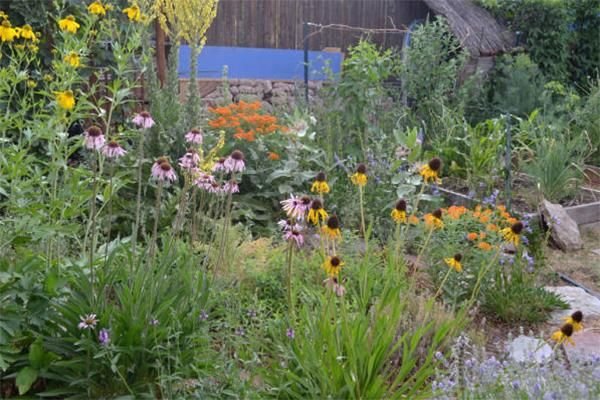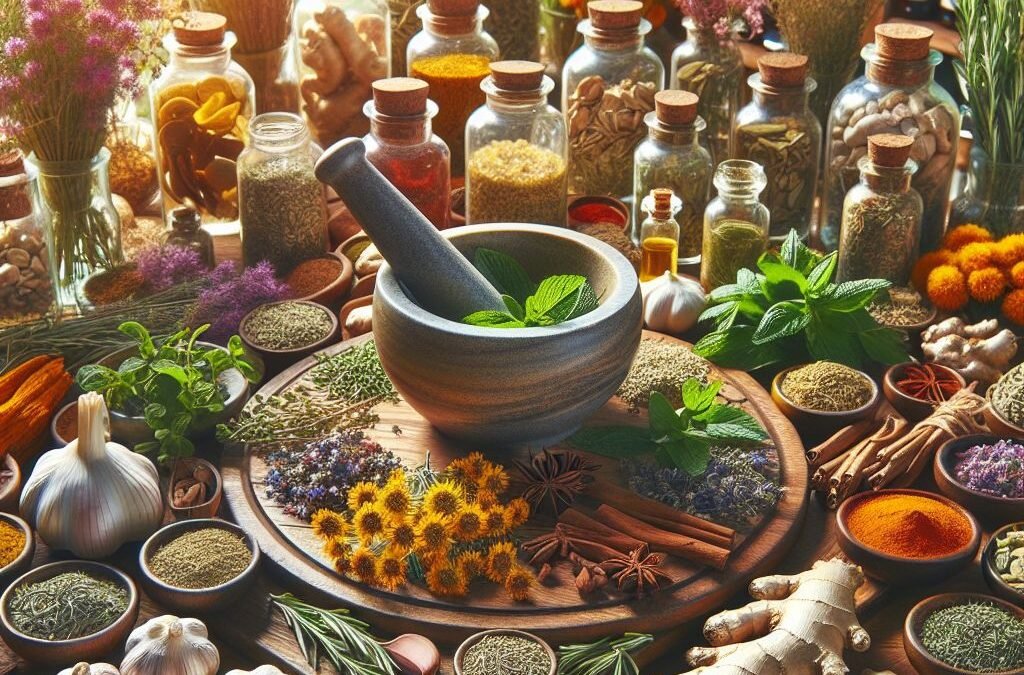Key Takeaways
- Identify the top medicinal plants that are easy to grow and can provide a range of health benefits.
- Learn how to assess and prepare your space to create a thriving medicinal garden.
- Understand the importance of soil quality and sunlight for plant growth and how to optimize these elements.
- Get practical tips for choosing the right plants for your garden’s unique conditions and your health needs.
- Discover sustainable gardening techniques to maintain your medicinal garden and ensure a bountiful harvest.
Embrace Your Green Thumb
 There’s something truly special about planting a seed, nurturing it, and watching it grow into a plant that can heal. Whether you have acres of land or just a few pots on a balcony, starting a medicinal garden can be a transformative step towards self-sufficiency and holistic wellness. Let’s embark on this journey together, where every plant tells a story and every harvest brings a sense of accomplishment.
There’s something truly special about planting a seed, nurturing it, and watching it grow into a plant that can heal. Whether you have acres of land or just a few pots on a balcony, starting a medicinal garden can be a transformative step towards self-sufficiency and holistic wellness. Let’s embark on this journey together, where every plant tells a story and every harvest brings a sense of accomplishment.
Buy this Self Sufficient Garden Book Now
Why Medicinal Gardens are Essential to Homesteading
 Medicinal gardens are not just about growing plants; they’re a statement of independence. With the right herbs at your fingertips, you can soothe a headache, calm an upset stomach, or treat a skin irritation. This isn’t just gardening—it’s taking control of your well-being, one plant at a time. And the beauty of it? These remedies are natural, without the long list of side effects that often come with conventional medicine.
Medicinal gardens are not just about growing plants; they’re a statement of independence. With the right herbs at your fingertips, you can soothe a headache, calm an upset stomach, or treat a skin irritation. This isn’t just gardening—it’s taking control of your well-being, one plant at a time. And the beauty of it? These remedies are natural, without the long list of side effects that often come with conventional medicine.
Top Medicinal Plants to Start Your Garden
Now, you might be wondering, “What plants should I grow?” Here’s a starter list to consider:
- Chamomile: A gentle herb for calming nerves and aiding sleep.
- Lavender: Known for its soothing fragrance and ability to relieve stress.
- Mint: Great for digestion and a refreshing addition to drinks.
- Echinacea: Boosts the immune system and fights off colds.
- Calendula: Heals skin irritations and wounds with its antifungal and antibacterial properties.
Choose plants that resonate with your health goals and are suitable for your climate. Remember, it’s not just about the number of plants, but the quality of care you give them.

Steps to Cultivate Your Medicinal Garden
Assessing Your Space: Where to Begin
Before you start, take a good look at your space. Do you have a backyard, a balcony, or just a windowsill? Don’t worry about the size; even the smallest space can yield an impressive array of herbs. The key is to understand your limitations and work within them. If you’re tight on space, consider container gardening or vertical planters. It’s all about making the most of what you have.
Next, think about the amount of sunlight your space receives. Most medicinal herbs thrive in full sun, which means at least six hours of direct sunlight a day. If you’re dealing with a shady area, don’t fret. There are shade-tolerant herbs like lemon balm and valerian that can still flourish in your garden.
Soil and Sunlight: The Foundations of Growth
 Soil isn’t just dirt—it’s a living, breathing foundation that nourishes your plants. To give your medicinal herbs the best start, aim for soil that is rich in organic matter, well-draining, and loose. You can improve your soil by adding compost, which is like a vitamin boost for your plants. For a deeper understanding of the earth’s composition and how it supports life, consider exploring the wondrous workings of planet Earth.
Soil isn’t just dirt—it’s a living, breathing foundation that nourishes your plants. To give your medicinal herbs the best start, aim for soil that is rich in organic matter, well-draining, and loose. You can improve your soil by adding compost, which is like a vitamin boost for your plants. For a deeper understanding of the earth’s composition and how it supports life, consider exploring the wondrous workings of planet Earth.
Sunlight is another crucial factor. Plants use sunlight to photosynthesize and create the nutrients they need to grow strong and healthy. Too little light and your herbs may become leggy and weak; too much, and they might wilt or burn. It’s a delicate balance, but once you find the sweet spot, your garden will thrive.
Choosing the Right Medicinal Plants
Choosing the right plants for your medicinal garden is like picking a team of superheroes, each with their own special powers. Think about the common health issues you encounter. Do you often deal with stress? Lavender might be your hero. Struggle with indigestion? Peppermint to the rescue! The key is to match your plants to your needs.
But it’s not just about what they can do for you. You have to consider if your garden is the right environment for them. Some plants love the heat, while others prefer cooler climates. And let’s not forget about your local wildlife—deer might love your garden as much as you do, but for entirely different reasons. So, choose plants that are not only beneficial for your health but also compatible with your garden’s conditions.
Option A.
Sustainable Garden Care Techniques
 Sustainability is the name of the game when it comes to caring for your garden. It’s about working with nature, not against it. This means choosing local plant varieties when possible, conserving water, and using natural methods to manage pests. Every choice you make should aim to minimize waste and promote a healthy ecosystem in your backyard.
Sustainability is the name of the game when it comes to caring for your garden. It’s about working with nature, not against it. This means choosing local plant varieties when possible, conserving water, and using natural methods to manage pests. Every choice you make should aim to minimize waste and promote a healthy ecosystem in your backyard.
Buy this Self Sufficient Garden Book Now
Water Wise: Irrigation Tips for Thriving Plants
Water is precious, and in the garden, it’s important to use it wisely. Drip irrigation systems are fantastic because they deliver water directly to the roots, where it’s needed most, reducing evaporation and waste. If you’re watering by hand, do it early in the morning or late in the evening to avoid the heat of the day. And always remember, it’s better to water deeply and less frequently to encourage strong root growth.
For example, a simple setup with a rain barrel can collect water for your garden, making use of natural rainfall and reducing your water bill.
Another tip is to mulch around your plants. Mulch helps retain soil moisture and keeps the roots cool. Plus, it can prevent weeds from taking over your precious garden space.
And don’t forget to pay attention to your plants. They’ll tell you when they’re thirsty—wilting leaves are a cry for help. Just remember, too much water can be just as bad as not enough, so make sure your soil drains well.
Natural Pest Control: Keeping Your Garden Healthy
When it comes to pests, your first line of defense is healthy plants. Strong plants are less likely to succumb to invasions. But when pests do show up, opt for natural solutions. Introduce beneficial insects like ladybugs to tackle aphids, or plant marigolds to deter nematodes. And always keep a close eye on your plants—catching a problem early is key to natural pest control.
Harvesting and Preserving Your Bounty
 The moment you’ve been waiting for—harvest time! But timing is everything. Pick your herbs when they’re at their peak potency, which is usually just before they flower. Early morning is best, after the dew has evaporated but before the sun is high. This is when their essential oils are strongest.
The moment you’ve been waiting for—harvest time! But timing is everything. Pick your herbs when they’re at their peak potency, which is usually just before they flower. Early morning is best, after the dew has evaporated but before the sun is high. This is when their essential oils are strongest.
Once harvested, you’ll want to preserve your bounty. Drying is a popular method because it’s easy and retains much of the herbs’ medicinal qualities. Hang bunches upside down in a warm, airy place, or lay them out on a screen. Some herbs can also be frozen or made into oils and tinctures for longer shelf life.
When to Harvest for Maximum Potency
Knowing when to harvest isn’t just about the time of day or the plant’s life cycle; it’s also about understanding the parts of the plant you need. For leaves, harvest before the plant flowers. For roots, autumn is often the best time, after the plant’s energy has focused downward. Flowers should be picked when they’re fully open, and seeds when they’re mature. For those interested in the broader implications of plant life, discovering the wondrous workings of planet Earth can provide additional insights.
It’s not just about quantity; it’s about quality. Your goal is to capture the essence of the plant, its vitality, and healing properties. That’s the real treasure of your medicinal garden.
Drying and Storage for Long-Term Use
Drying herbs is both an art and a science. You want to dry them quickly enough to prevent mold, but slowly enough to retain their therapeutic properties. Once dried, store your herbs in airtight containers, away from light and heat, to maintain their potency. Label each container with the herb’s name and the date of harvest, so you’ll always know what you have on hand.
Some herbs, like basil and cilantro, are best used fresh, but they can also be preserved in oil or frozen in ice cube trays for a burst of flavor and health benefits in your winter soups and stews.
From Garden to Apothecary
 Your medicinal garden is more than just a plot of land—it’s a living pharmacy. With the right knowledge, you can transform your harvest into tinctures, salves, and teas. It’s empowering to know that the simple act of sipping a cup of mint tea or applying a calendula salve is a step towards natural healing and self-sufficiency.
Your medicinal garden is more than just a plot of land—it’s a living pharmacy. With the right knowledge, you can transform your harvest into tinctures, salves, and teas. It’s empowering to know that the simple act of sipping a cup of mint tea or applying a calendula salve is a step towards natural healing and self-sufficiency.
Remember, the journey to a medicinal garden is a personal one. Start small, be patient, and enjoy the process. Nature has a lot to teach us, and there’s no better teacher than a garden. For those interested in getting started, here’s a guide on easy to grow herbs for your homestead medicinal herb garden.
Creating tinctures and extracts from your own garden is both cost-effective and deeply satisfying. To make a tincture, simply chop your fresh herbs and cover them with alcohol or vinegar in a clean jar. Let this mixture sit for a few weeks, shaking it daily. After that, strain out the herbs, and voila, you have a potent remedy for a variety of ailments.
For example, echinacea tincture can be used at the first sign of a cold to boost your immune system, while a calendula extract might be applied to a skin rash for its soothing and healing properties.
Herbal Remedies for Common Ailments
With your medicinal garden, you can create remedies for common ailments that are tailored to your family’s needs. Here are a few simple preparations you can make:
- Chamomile tea: Perfect for a calming bedtime ritual to encourage sleep.
- Mint infusion: Ideal for soothing an upset stomach or aiding digestion.
- Lavender oil: Can be applied to the temples to relieve headaches or stress.
Remember, the best remedies are those made with love and care from plants you’ve grown yourself. They carry not just the healing properties of the herbs but also the energy and intention you put into them.
Buy this Self Sufficient Garden Book Now
FAQs
How much space do I need to start a medicinal garden?
You don’t need a lot of space to start a medicinal garden. Even a few pots on a sunny windowsill can yield a surprising variety of herbs. Think vertically with hanging baskets or wall-mounted planters if you’re short on ground space. The key is to utilize whatever space you have efficiently.
What are some easy-to-grow medicinal plants for beginners?
Here are a few easy-to-grow medicinal plants that are perfect for beginners:
- Peppermint: Thrives in both pots and the ground, and can be used for digestive issues.
- Lemon balm: Grows quickly and is great for reducing stress and anxiety.
- Aloe vera: Requires minimal care and is excellent for skin healing and burns.
- Calendula: Easy to grow from seed and can be used to make healing salves.
These plants are forgiving and require minimal care, making them ideal for those just starting out.
Can I grow a medicinal garden in a cold climate?
Yes, you can grow a medicinal garden in a cold climate. Choose plants that are hardy to your zone, and consider using cold frames or a greenhouse to extend the growing season. Some herbs, like lemon balm and mint, can be grown indoors during the winter months.
For instance, a gardener in a cold climate successfully grew ginger indoors by creating a mini-greenhouse with a clear storage bin, providing extra warmth and humidity.
How do I preserve my medicinal herbs to last through winter?
To preserve your medicinal herbs through winter, you can dry them, make them into tinctures or infusions, or freeze them. Drying is one of the simplest methods and can be done by hanging the herbs in bunches or laying them flat on a screen in a warm, airy space.
Are there any medicinal plants I should avoid due to potential toxicity?
Yes, there are medicinal plants that should be avoided or used with caution due to potential toxicity. For example, foxglove is the source of the heart medicine digitalis but is poisonous if consumed directly. Always research each plant thoroughly and consult with a healthcare provider before using any plant medicinally, especially if you have underlying health conditions or are taking other medications.
Option A.

